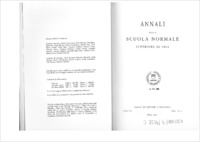Due tavole della Vergine nella Toscana occidentale del primo Duecento
BHAP-HA+SCANT
- Bacci, Michele Université de Fribourg
-
1997
Published in:
- Annali della Scuola Normale Superiore di Pisa. - 1997, vol. IV, no. 2, p. 1
English
This article discusses two different objects that point out the importance played by Byzantine or Byzantinizing images in the religious experience of early 13th century Italy. The first example is the icon of the Madonna di sotto gli organi worshipped in Pisa Cathedral: the analysis of its iconographic and stylistic features enables its identification as a work made in the Eastern Mediterranean, possibly Cyprus, at the beginning of the 13th century. The article points out the impact played by this object on contemporary maniera graeca in Pisa and evaluates in more general terms the role played by icons in fostering the involvement of painted panels made according to Byzantine patterns in both private and public piety. This is illustrated by the analysis of a previously unpublished work in the Villa Guinigi Museum in Lucca, which shows a free use of iconographic features borrowed from Eastern tradition.
- Faculty
- Faculté des lettres et des sciences humaines
- Department
- Département d'histoire de l'art et d'archéologie
- Language
-
- Italian
- Classification
- Art history
- License
- License undefined
- Identifiers
-
- RERO DOC 306432
- Persistent URL
- https://folia.unifr.ch/unifr/documents/306215
Statistics
Document views: 79
File downloads:
- baccimichele1997duetavoledellaverginenellatoscanaoccidentaledelprimoduecentosmall.pdf: 232
